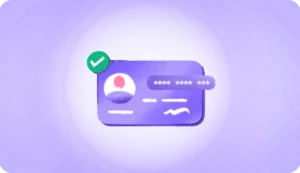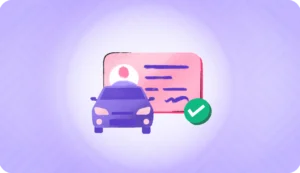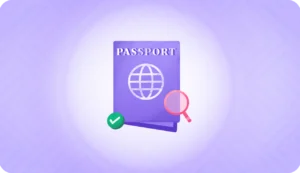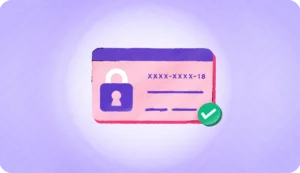In our digitally interconnected world, the ability to verify a government-issued identification number has become more crucial than ever. These unique identifiers, issued by authorized government agencies, play a pivotal role in establishing a person’s identity and linking them to various official records.
Navigating the complexities of different identification forms, coupled with stringent data privacy laws and varied legal restrictions, can make this task daunting. The rise in online activity has only amplified these challenges, leading to an increased risk of fraud and identity theft. As such, there’s a pressing need for a secure and reliable solution to streamline this process. A solution that not only ensures the accuracy of identification document issued, but also upholds the highest standards of security and compliance.
In this article, we will explore the intricacies of government-issued identity document verification, shedding light on its importance and the need for a robust system to navigate its complexities effectively.
What is a Government-issued Identification Number?
A government-issued identification number is a unique numerical identifier assigned to individuals by government bodies. These numbers are not just random sequences; they are pivotal in confirming an individual’s identity. Think of them as digital fingerprints, distinct and integral to each person. The importance of verifying these numbers cannot be overstated.
In today’s world, where identity fraud is rampant, these identification numbers serve as a crucial line of defense. They are key to identifying and preventing fraud, thereby playing a significant role in compliance with mandatory Know Your Customer (KYC) and anti-money laundering (AML) regulations.
Accurate verification of these numbers ensures that individuals are who they claim to be, thereby safeguarding various facets of societal interaction, from financial transactions to national security.
Examples of Government-issued Identification Numbers
- Passport: A critical document for international travel, each passport has a unique number that helps in identifying the bearer internationally.
- Social Security Number (SSN): In many countries, SSN is a fundamental identifier for citizens and residents, used in a range of services from tax filing to accessing government benefits.
- Driver’s License Number: Issued by individual states or countries, these numbers not only permit driving but also act as a widely accepted form of personal identification.
- Individual Tax Identification Numbers (ITIN): Specifically assigned for tax processing, ITINs are used by individuals who are required to have a U.S. taxpayer identification number but do not have, and are not eligible to obtain, a Social Security number.
With these identifiers playing such a vital role, it’s imperative to have robust systems in place for their verification. This ensures not only the security of personal identities but also the integrity of various systems that rely on these identification numbers to identify themselves.
How to Verify Government-issued Identification Numbers?
Verifying a government-issued identification number is a multi-step process that involves various technological and procedural elements. This process begins with the collection and analysis of the valid ID document in question. The key here is to ensure the document is genuine and belongs to the person presenting it.
Collect and Analyze the ID
The initial step is to gather the necessary ID documents. This involves not just physical collection but also a thorough examination to check for signs of alteration or forgery.
Read more: How does the ID OCR process work?
Extract and Compare Data
Once the ID is collected, the next step involves extracting and comparing the data. This is where Optical Character Recognition (OCR) software comes into play. OCR technology is designed to accurately read and convert different types of documents, including government IDs, into machine-encoded text. This process allows for maximum efficiency in document processing for additional information, such as name, date of birth, and the identification number itself.
Read more:
- What is machine readable zone and how does it work?
- Buyer’s Guide to Choosing the Best OCR software
Validate the ID
The final step in this process is the validation of the ID. This involves checking the authenticity of the ID against relevant databases or standards. For instance, in the United States, the American Association of Motor Vehicle Administrators (AAMVA) standard is often used for driver’s license verification.
Related Reads:
- What is Intelligent Document Processing (IDP)
- Optical Character Recognition (OCR) vs Intelligent Character Recognition (ICR): What’s the Difference?
Advancements in Online Government ID Verification
The field of online government ID verification has seen significant advancements in recent years. One notable development is the emergence of electronic government identification, which includes innovations like mobile driver’s license verification and e-passports. These digital forms of identification not only streamline the verification process but also enhance security measures.
Biometric authentication is another frontier in ID verification. The use of facial recognition technology, for instance, has shown promise in various applications, including enhancing election security to prevent voter fraud. Such technologies offer a more secure and efficient way of verifying identities, aligning with the increasing need for robust digital security measures.
Read more about OCR automation.
Advantages of Verifying Government-issued Identification Numbers
- Prevention of Fraud: Crucial in detecting and preventing identity theft and fraudulent activities.
- Enhanced Security: Adds an extra layer of security, ensuring authorized access only.
- Compliance with Regulations: Essential for KYC and AML regulations.
- Streamlined Processes: Makes administrative tasks more efficient.
- Trust and Reliability: Builds consumer trust in systems and services.
Limitations of Verifying Government-issued Identification Numbers
- Complexity of Verification: The process involves scrutinizing IDs for fraud and verifying against databases, which can be complex and time-consuming.
- Added Friction: The process can cause drop-offs due to the hesitancy around sharing personal information.
- Vulnerability to Fraud: Despite precautions, government IDs aren’t foolproof against advanced fraudulent tactics like deepfakes.
- Equity Issues: Not everyone has access to government IDs, which can lead to exclusion from certain services.
- Technological Limitations: Continual updates are needed to combat sophisticated forgeries and evolving fraud methods.
The Imperative of a Comprehensive Identity Verification Solution
Relying solely on government-issued photo ID verification presents inherent risks and limitations. In today’s fast-evolving digital landscape, a comprehensive identity verification solution becomes not just beneficial, but imperative. Such a solution should encompass more than just government ID checks. It should integrate advanced features like document verification, phone verification, and extensive database checks to provide a multi-layered approach to identity verification.
HyperVerge’s end-to-end identity verification solution embodies these principles. It offers a robust combination of features designed to ensure thorough and efficient verification. By employing sophisticated technologies like AI and machine learning, HyperVerge goes beyond basic ID checks, offering a more comprehensive, secure, and reliable identity verification process.
Explore the full potential of comprehensive identity verification with HyperVerge’s document verification service. Ready to take the next step? Sign up now and transform your verification process.
FAQs
Q. What information is included in government-issued IDs?
Government-issued IDs typically include key personal details such as the individual’s full name, date of birth, a unique identification number, photograph, signature, and address, and sometimes physical characteristics like height and eye color. These elements collectively help in verifying the identity of the holder.
Q. Is a social security number a government-issued identification number?
Yes, a social security number (SSN) is a government-issued identification number. In many countries, SSNs are issued by government agencies and serve as a primary identifier for citizens and residents, especially for tax and social welfare purposes.
Q. What is the difference between state and federal government-issued IDs?
State-issued IDs are provided by individual states and typically include driver’s licenses and state ID cards. Federal government-issued IDs, on the other hand, are issued by the national government and include passports, military IDs, and social security cards. The primary difference lies in the issuing authority and the scope of use – state IDs are often used for state-level local identification, while federal IDs have a broader, often international, application.





